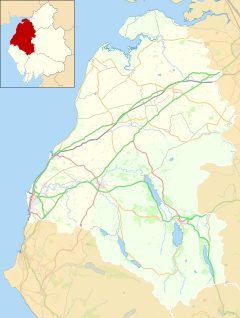Dearham railway station was on the single track Derwent Branch of the Maryport and Carlisle Railway (M&CR) in the then county of Cumberland, now Cumbria, England.
Dearham | |||||
|---|---|---|---|---|---|
| General information | |||||
| Location | Dearham, Cumberland England | ||||
| Coordinates | 54°42′28″N 3°25′50″W / 54.7077°N 3.4306°W | ||||
| Grid reference | NY078356 | ||||
| Platforms | 1[1] | ||||
| Other information | |||||
| Status | Disused | ||||
| History | |||||
| Original company | Maryport & Carlisle Railway | ||||
| Post-grouping | London Midland and Scottish Railway | ||||
| Key dates | |||||
| 1 June 1867 | Opened | ||||
| 29 April 1935 | Station and line closed[2] | ||||
| |||||
Maryport and Carlisle Railway | |||||||||||||||||||||||||||||||||||||||||||||||||||||||||||||||||||||||||||||||||||||||||||||||||||||||||||||||||||||||||||||||||||||||||||||||||||||||||||||||||||||||||||||||||||||||||||||||||||||||||||||||||||||||||||||||||||||||||||||||||||||||
|---|---|---|---|---|---|---|---|---|---|---|---|---|---|---|---|---|---|---|---|---|---|---|---|---|---|---|---|---|---|---|---|---|---|---|---|---|---|---|---|---|---|---|---|---|---|---|---|---|---|---|---|---|---|---|---|---|---|---|---|---|---|---|---|---|---|---|---|---|---|---|---|---|---|---|---|---|---|---|---|---|---|---|---|---|---|---|---|---|---|---|---|---|---|---|---|---|---|---|---|---|---|---|---|---|---|---|---|---|---|---|---|---|---|---|---|---|---|---|---|---|---|---|---|---|---|---|---|---|---|---|---|---|---|---|---|---|---|---|---|---|---|---|---|---|---|---|---|---|---|---|---|---|---|---|---|---|---|---|---|---|---|---|---|---|---|---|---|---|---|---|---|---|---|---|---|---|---|---|---|---|---|---|---|---|---|---|---|---|---|---|---|---|---|---|---|---|---|---|---|---|---|---|---|---|---|---|---|---|---|---|---|---|---|---|---|---|---|---|---|---|---|---|---|---|---|---|---|---|---|---|---|---|---|---|---|---|---|---|---|---|---|---|---|---|---|---|---|
| |||||||||||||||||||||||||||||||||||||||||||||||||||||||||||||||||||||||||||||||||||||||||||||||||||||||||||||||||||||||||||||||||||||||||||||||||||||||||||||||||||||||||||||||||||||||||||||||||||||||||||||||||||||||||||||||||||||||||||||||||||||||
The station was opened in 1867, situated on the south eastern edge of Dearham village. There was a passing loop and a siding at the station.[3]
Passenger services
editAll passenger trains along the branch line called at Dearham station.
The initial service in August 1867 consisted of two trains each way between Bullgill (written then as "Bull Gill") and Brigham calling at Dearham and Papcastle, Monday to Saturday. By November of that year this had been doubled, with all trains reversing at Brigham to run to and from Cockermouth.
By June 1876 this pattern continued, with two trains added each way on Sundays between Cockermouth and Bullgill.
From 1887 to 1914 five trains started from Maryport with a sixth from Bullgill, all with balancing services, Monday to Saturday. It is not clear whether passengers had to change at Bullgill or whether a reversal took place there as well as at Brigham. Two trains from Maryport and one Bullgill, with balancing services, ran on Sundays. Dearham Bridge and Papcastle were shown as "Signal Stops" where intending passengers had to inform railway staff who would stop the train accordingly.
Much was made locally of the fact that it was quicker to use the through coach from Carlisle to Cockermouth via the branch than to go via Penrith or Workington.
In 1914 Sunday trains were withdrawn.[4]
Sources differ when Papcastle closed. One says it lost even its Signal Stop status (by implication, closed) in 1914[5] whilst another gives its closure date as 1921.[6]
The journey time from Cockermouth to Bullgill averaged 25 minutes.
In 1922 six trains called at the station in each direction, Monday to Saturday, with no Sunday service.[7]
Closure
editThe service through the station survived until 1935.
Unusually for those times the tracks were lifted not long after closure, with a tragic consequence, when a bridge was being demolished a girder fell on two men and killed them.[8]
Afterlife
editBy 2013 little trace of the station remained.
| Preceding station | Disused railways | Following station | ||
|---|---|---|---|---|
| Bullgill Line and station closed |
Maryport & Carlisle Railway Derwent Branch |
Linefoot Line and station closed |
See also
editReferences
edit- ^ Robinson 2002, p. 14.
- ^ Quick 2009, p. 146.
- ^ Jones 2020, pp. 288–301.
- ^ Colman 1982, pp. 10–12.
- ^ Colman 1982, p. 12.
- ^ Quick 2009, p. 304.
- ^ Bradshaw 1985, p. 511.
- ^ Suggitt 2008, p. 97.
Sources
edit- Bradshaw, George (1985) [July 1922]. Bradshaw's General Railway and Steam Navigation guide for Great Britain and Ireland: A reprint of the July 1922 issue. Newton Abbot: David & Charles. ISBN 978-0-7153-8708-5. OCLC 12500436.
- Colman, C. V. (January 1982). Peascod, Michael (ed.). "Passenger Services on the Bolton and Derwent Branches". Cumbrian Railways. 2 (9). Pinner: Cumbrian Railways Association. ISSN 1466-6812.
- Jones, Allan (October 2020). Peascod, Michael (ed.). "The Derwent Branch of the Maryport and Carlisle Railway". Cumbrian Railways. 13 (8). Pinner: Cumbrian Railways Association. ISSN 1466-6812.
- Quick, Michael (2009) [2001]. Railway passenger stations in Great Britain: a chronology (4th ed.). Oxford: Railway & Canal Historical Society. ISBN 978-0-901461-57-5. OCLC 612226077.
- Robinson, Peter W. (2002). Cumbria's Lost Railways. Stenlake Publishing. ISBN 1 84033 205 0.
- Suggitt, Gordon (2008). Lost Railways of Cumbria (Railway Series). Newbury: Countryside Books. ISBN 978-1-84674-107-4.
Further reading
edit- Jowett, Alan (March 1989). Jowett's Railway Atlas of Great Britain and Ireland: From Pre-Grouping to the Present Day (1st ed.). Sparkford: Patrick Stephens Ltd. ISBN 978-1-85260-086-0. OCLC 22311137.
- Jowett, Alan (2000). Jowett's Nationalised Railway Atlas (1st ed.). Penryn, Cornwall: Atlantic Transport Publishers. ISBN 978-0-906899-99-1. OCLC 228266687.

